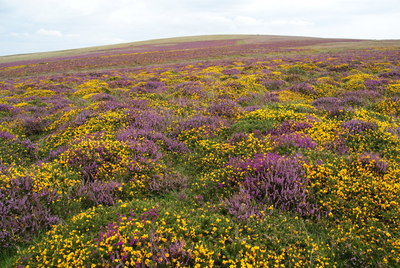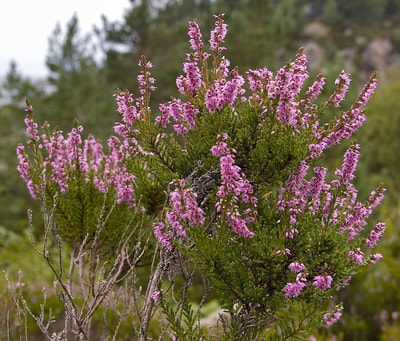|
Heather (Calluna vulgaris) Bell heather ( Erica cinerea) Cross-leaved ( E.tetralix)
To see the heath-flower withered on the hill, To listen to the woods expiring lay, To note the red leaf shivering on the spray, To mark the last bright tints the mountain stain, On the waste fields to trace the gleaner's way, And moralise on mortal joy and pain, Sir Walter Scott Qualities of Heather Ur that is Heath. Terrible tribe in cold dwellings, mould of the earth, Heath. Completion of lifelessness, the grave. Growing of plants. Book of Ballymote 1391 Heather Fact File Heather (Calluna vulgaris) Bell heather ( Erica cinerea) Cross-leaved ( E.tetralix) Ur (Gaelic/Ogham name) Heather- clad moors lift the spirits and speak of a unhindered freedom, of true love and of the soil and earth which it hugs with a protective embrace. Ur, the ogham name for heather is associated with the soil and the earth, confirming the heather’s relationship with the earth as its stems root into it forming a natural bed. This has been used as an analogy in stories of lovers using the heather clad moor to lie upon as well as a practical usage as bedding in the past. To bed someone in older times was to make a lasting commitment, a meaningful relationship of unconditional love. In the great epic – the pursuit of Diarmaid and Grainne they finally embrace each other on a bed of heather collected by Diarmid. A Scottish ballad talks of a passion a women has for Black Jack Davy preferring to lie with him on heather-clad moors as opposed to a comfortable bed at home. King Henry in a folk song beds a hideous hag on the green heather to be greeted by a fair woman of beauty the following morning. This is an age-old tradition of the King giving respect to all aspects of the sacred land no matter how beautiful or ugly. Ur can also mean ‘new’ which may point to an acceptance of death. In Scotland they speak of the white sleep- a dead person awaiting new life . As with the hideous hag, we see things turned around again when working with heather as death is seen as a new birth into another life and birth as a death to a previous life. Maybe this is why the Gaelic word for heather, ‘Fraoch’ means fierce or war-like as it is the warriors that risk death to return in glory into a new life in Celtic traditions. Fraoch is a famous Irish warrior whose wife Boand is daughter to Aoife and Chulainn who are both legendary warriors of high repute. Fraoch heather ale is probably the oldest style of ale brewed in the world, brewed since 2000BC in Scotland. Calluna vulgaris is the most common of the three heathers mentioned above. The word Calluna comes from the greek meaning ‘ to brush’ and this species is ideal to make brushes and brooms and is also the heather most commonly referred to as ling. Ling comes from the Anglo-Saxon word lig meaning fire, and therefore reminds us of its use especially in Scotland for a fuel. In fact in Scotland the word 'ling' refers to any rush or coarse grass growing on the heath. This heather has purple flowers which are occasionally white. Heather flowers are a great source of nectar for bees producing prize honey. The red grouse will feed upon the young shoots and the birds will feast upon its seed. The bell heather is the main species cultivated for garden use, a much shrubbier habit with bright bell like flowers. The cross-leaved heather is very similar but grows in wetter areas and its leaves are borne in fours (tetralix incorporates the greek word for four) as opposed to three borne by the bell heather. These whorls of four leaves form a cross when looked down upon and also fold down to conserve moisture by lessening evaporation. Heather has been used to make robe and thatch as well as brooms and brushes and strong ale. Medicinally it is said to help ease the pain of migraine and menstruation. If you would like to learn more about the folklore of our flora subscribe to our free Newsletter HERE or enrol on a Tree Folklore course HERE
0 Comments
Leave a Reply. |
Details
Poetry of flowersJoin me to explore the flora of the British Isles on this blog. My intention is to attempt to capture the unique quality and beauty of each species of flower, tree or shrub. For every species featured I will be growing many more wildflowers to celebrate the joy of their existence, their intrinsic conservation value and bewildering array of uses. For nearly 30 years I have noted, studied and explored wildflowers in the field much to the patience of the walker beside me. To share this passion is a heartfelt plea to respect, preserve and care for all British Wildflowers no matter how common they seem. Archives
February 2024
Categories |



 RSS Feed
RSS Feed
